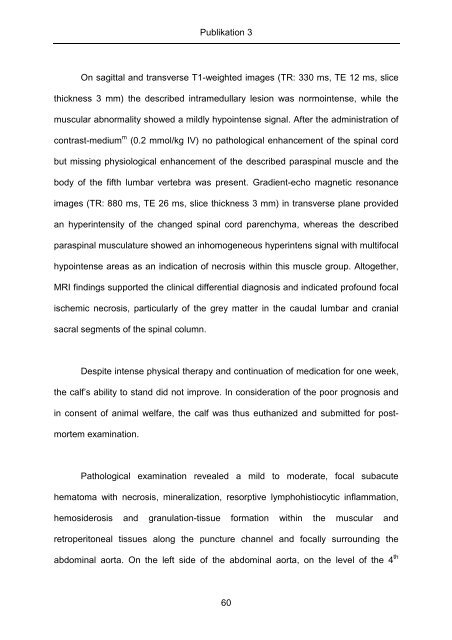Tierärztliche Hochschule Hannover Vergleichende Studie zur
Tierärztliche Hochschule Hannover Vergleichende Studie zur
Tierärztliche Hochschule Hannover Vergleichende Studie zur
You also want an ePaper? Increase the reach of your titles
YUMPU automatically turns print PDFs into web optimized ePapers that Google loves.
Publikation 3<br />
On sagittal and transverse T1-weighted images (TR: 330 ms, TE 12 ms, slice<br />
thickness 3 mm) the described intramedullary lesion was normointense, while the<br />
muscular abnormality showed a mildly hypointense signal. After the administration of<br />
contrast-medium m (0.2 mmol/kg IV) no pathological enhancement of the spinal cord<br />
but missing physiological enhancement of the described paraspinal muscle and the<br />
body of the fifth lumbar vertebra was present. Gradient-echo magnetic resonance<br />
images (TR: 880 ms, TE 26 ms, slice thickness 3 mm) in transverse plane provided<br />
an hyperintensity of the changed spinal cord parenchyma, whereas the described<br />
paraspinal musculature showed an inhomogeneous hyperintens signal with multifocal<br />
hypointense areas as an indication of necrosis within this muscle group. Altogether,<br />
MRI findings supported the clinical differential diagnosis and indicated profound focal<br />
ischemic necrosis, particularly of the grey matter in the caudal lumbar and cranial<br />
sacral segments of the spinal column.<br />
Despite intense physical therapy and continuation of medication for one week,<br />
the calf’s ability to stand did not improve. In consideration of the poor prognosis and<br />
in consent of animal welfare, the calf was thus euthanized and submitted for postmortem<br />
examination.<br />
Pathological examination revealed a mild to moderate, focal subacute<br />
hematoma with necrosis, mineralization, resorptive lymphohistiocytic inflammation,<br />
hemosiderosis and granulation-tissue formation within the muscular and<br />
retroperitoneal tissues along the puncture channel and focally surrounding the<br />
abdominal aorta. On the left side of the abdominal aorta, on the level of the 4 th<br />
60










![Tmnsudation.] - TiHo Bibliothek elib](https://img.yumpu.com/23369022/1/174x260/tmnsudation-tiho-bibliothek-elib.jpg?quality=85)






